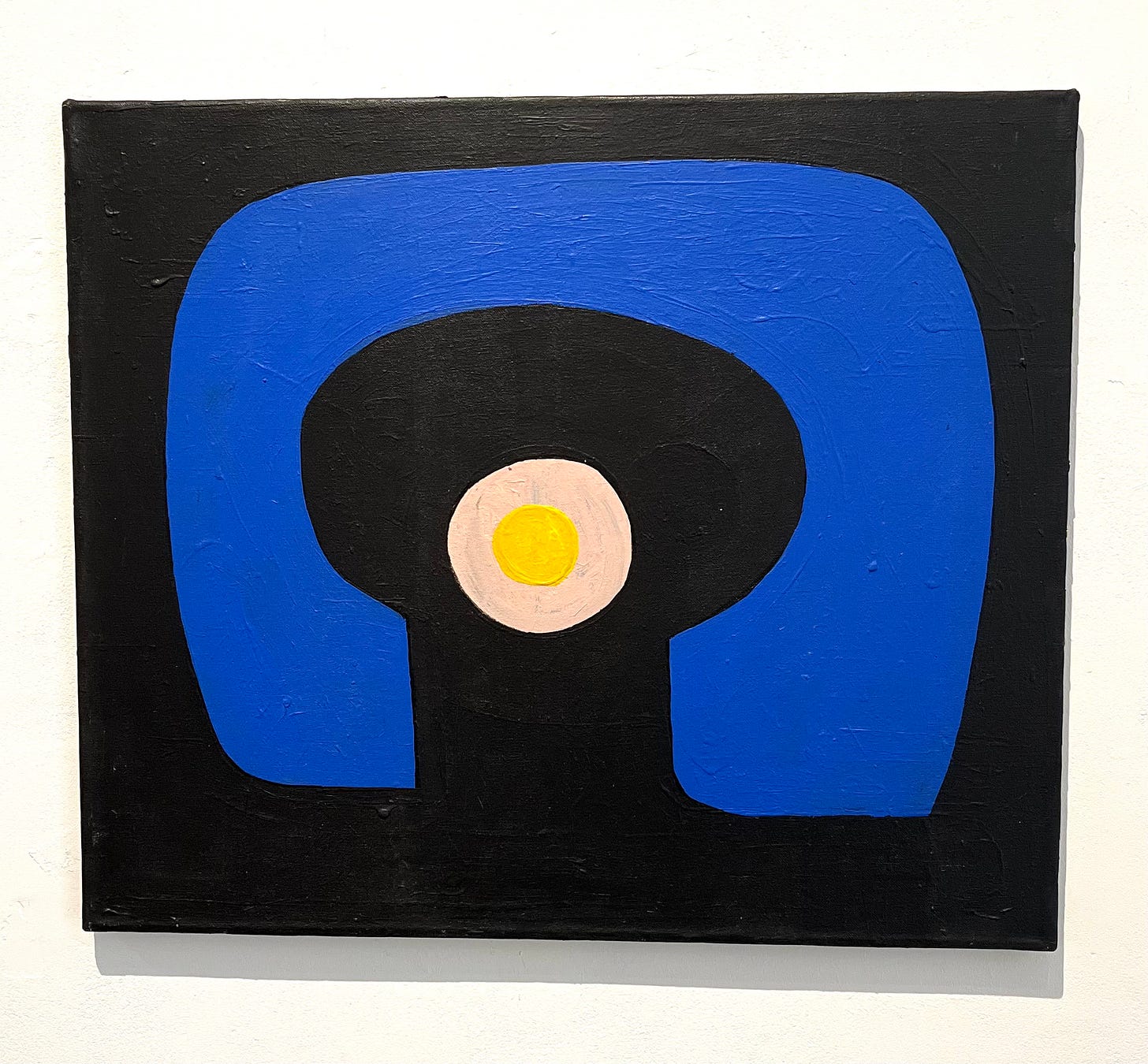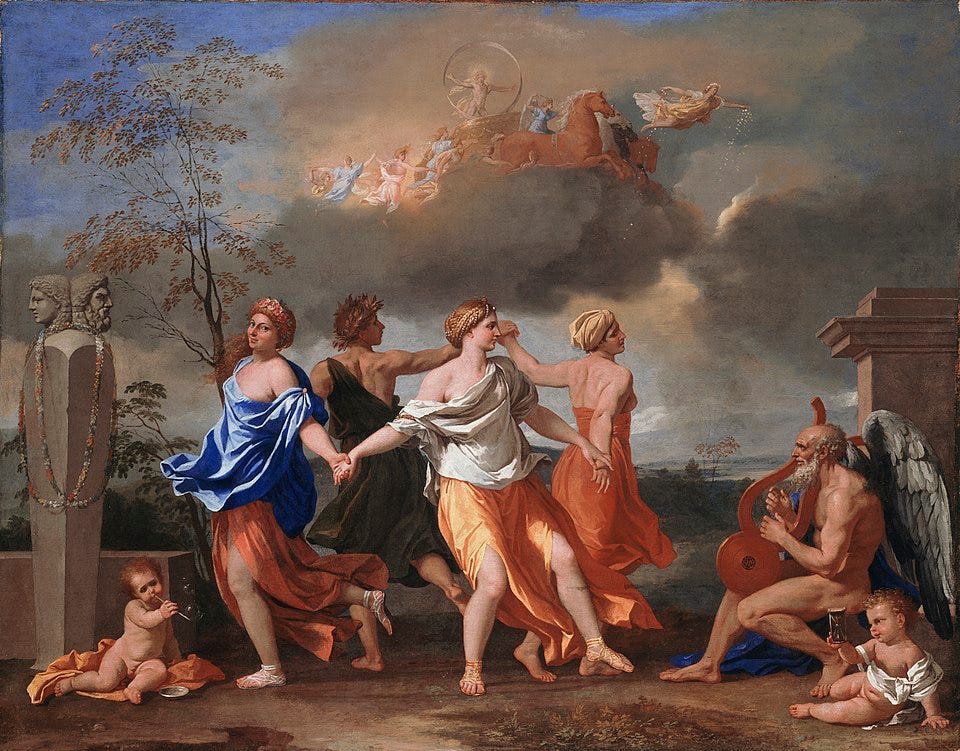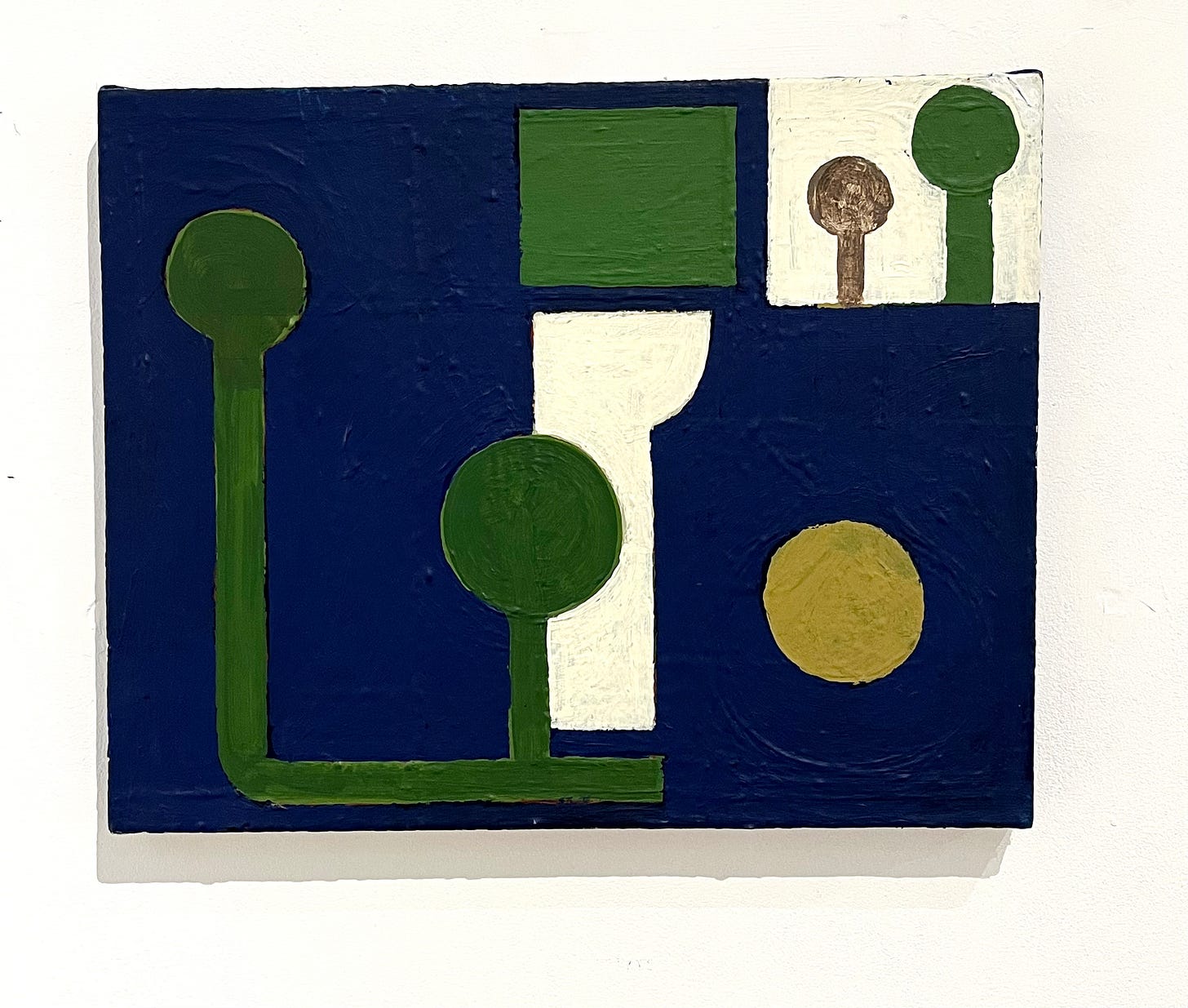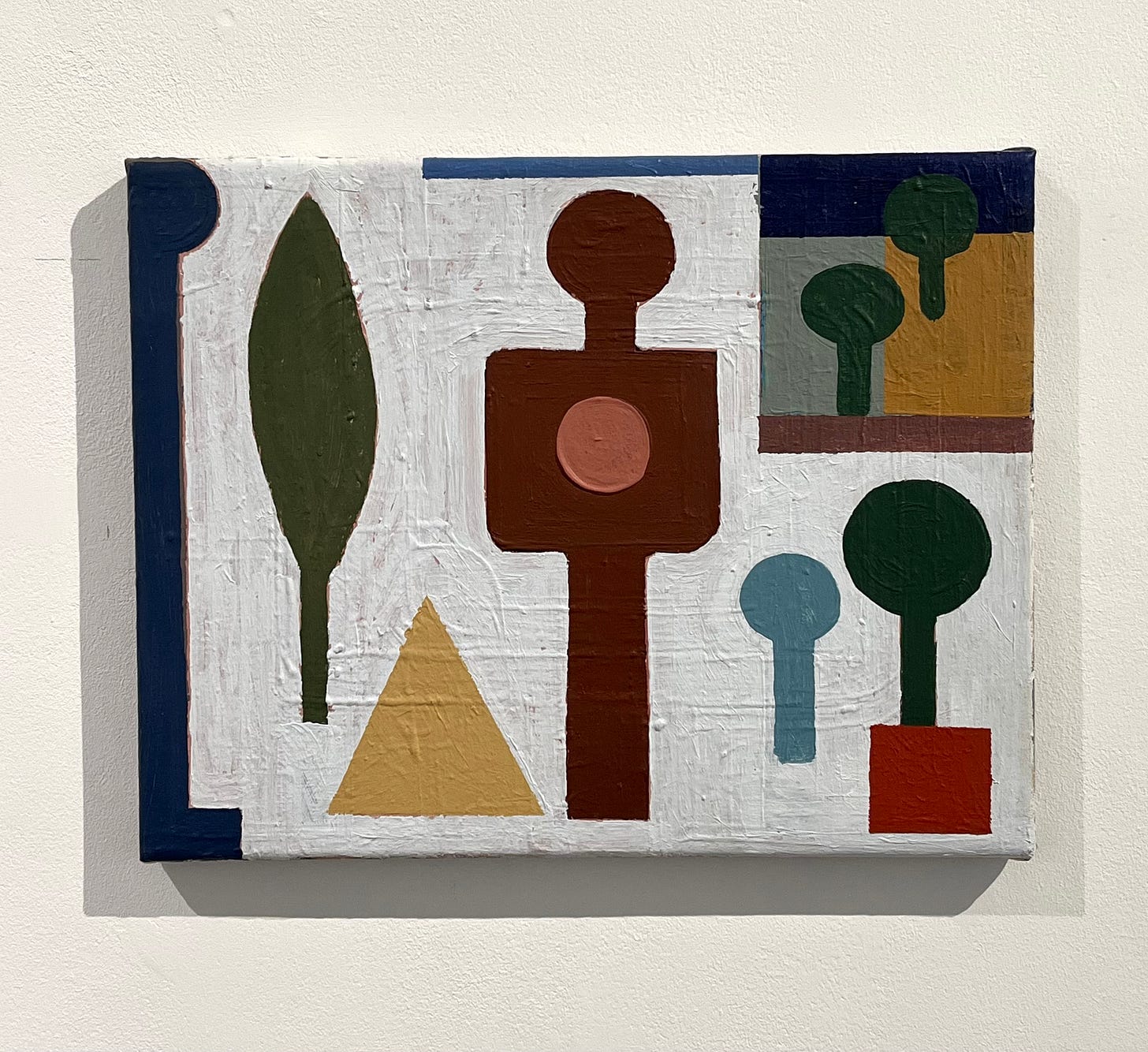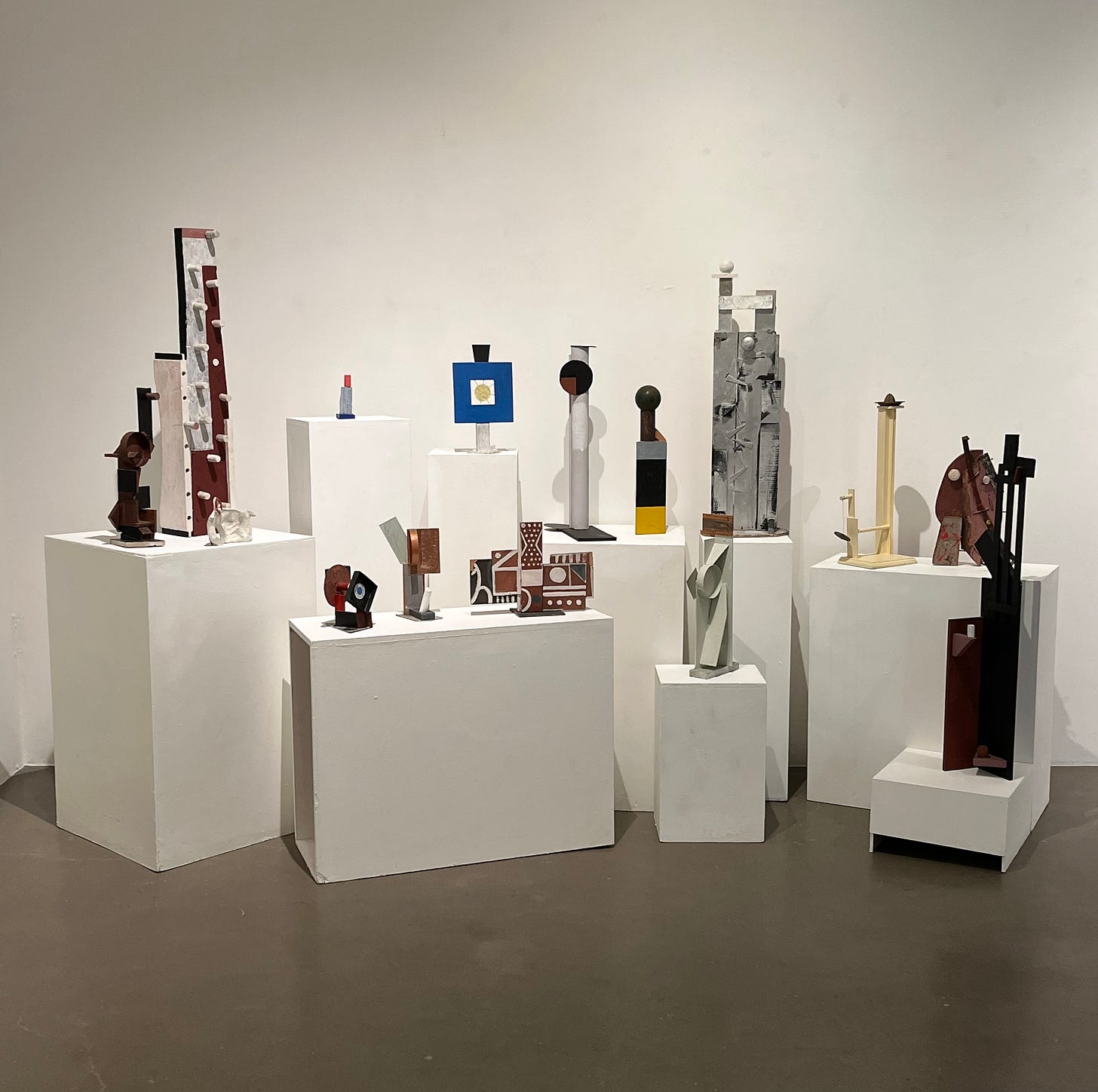Abstraction: a family history
A different kind of exhibition text for Geoffrey Rigden: ‘Under Cover’ APT Gallery, Deptford on display from 22 May – 1 June 2025
Geoffrey Rigden grew up with an awareness of secrets, of what could and could not be spoken about. His father, Stanley, had been a Royal Air Force navigator during the Second World War, dropping special agents into Czechoslovakia. He was shot down over Germany never to return. Given its undercover nature, Rigden never knew the details of his father’s mission.
Rigden’s work has an elusive quality. Throughout the painting and sculpture, forms are set askance as if the artist had an aversion to perfect symmetry. Critics did not fail to notice this irregularity, and reviews are consistently smattered with terms like ‘awkward’, ‘deceptively simple’, ‘hard to categorise’, ‘oddball’, ‘not immediately possible to gauge’, ‘holding something in reserve’, ‘somehow familiar yet unknowable’, ‘not wholly knowable, secretive’.
I first met the artist with my mum outside the Wallace Collection on a clear day in 2013, when I was about seventeen years old. He greeted her with a long, wordless hug. It was the first time he had seen his daughter in nearly forty years. We entered the gallery and he led us to a painting by Nicolas Poussin, A Dance to the Music of Time. As a matter of fact, I already knew the painting, as Rigden’s old school friend, Clive, who kept in touch with us, had sent me a postcard of it a few months before. I was familiar with the chain of dancing figures, allegorising the turning of the seasons. But I didn’t know till then that, if you look closely, the painting’s surface is covered in fingerprints. I was surprised to discover that this most erudite and aristocratic of artists painted with his fingers. What the artist had in mind, if anything, is unknown.
While that was the first time we met, I had already encountered Rigden’s work, many years earlier. When I was a boy my mum and I would go once or twice a year to a care home outside Lyme Regis to visit Joan, Rigden’s mother. Her life had been marked by chronic depression and she had undergone several rounds of electric shock therapy. She preferred not to leave her room, although during our visits she was always cheerful. I remember seeing cards on the mantlepiece across the room, drawings or watercolours with something distinctive about them, and over time I realised who they must have been from. We never looked at them closely, however, and he was never discussed.
My next encounter with Rigden’s work, still long before I met him, was in the window of a gallery on Cross Street in Islington. When it was one of our birthdays, my mum, dad and granny would go to a restaurant on Upper Street, and we would approach from that way. I remember hearing that Rigden had some work in an exhibition there. I recall looking through the window and seeing a painting of some shapes, but we didn’t linger long. Though I would often glance through the window as we walked past, I didn’t see it anything like it there again.
Geoffrey Rigden came to London in 1963 to enrol at the Royal College of Art. This was a combative time in British art history, with two opposite camps of painters, figurative and abstract. Rigden was among those who signalled their allegiance by refusing to do any life drawing. He won a junior John Moores Painting Prize in 1965, when the chair of the jury was critic Clement Greenberg. Greenberg expounded a strict and highly influential approach to painting, based on a particular definition of it: painting was simply the application of paint to a flat surface contained by one or more edges. To be modernist, painting had to frankly avow and draw attention to these properties rather than disguise them. The notion that a painting ought to reproduce the appearance of something else – like a landscape or the human figure – was evidence that the painter had misunderstood the essence of his craft. Rigden remained close to these principles. In a letter dated 28 October 2015, he told me that Greenberg’s essays had been ‘my Bible’. When asked in an interview what was his principal concern when making a painting, he replied, ‘getting it flat’.
The same year he came to London, Rigden married Pam. In 1966, the year he graduated from the Royal College of Art, their daughter, Kate, was born. The young family moved from their Kensington bedsit to a village in Kent called Woolage Green, and Rigden taught at the nearby Canterbury School of Art. The marriage didn’t last, and by 1975 the couple had separated. Rigden took on some teaching at Cyprus College of Art. Not long after, Pam moved back to London for work and Kate was enrolled at Barnsbury Girls’ School, a secondary school in Islington.
Rigden’s paintings consistently uphold the principle of pictorial flatness, but over the course of the 1980s they gradually become more opaque and less painterly. From the mid-2000s his work introduces forms which, although they remain articulated towards the rectangular canvas support, nonetheless represent the appearance of the outside world. Reflexion, for example, encodes a sense of space, albeit in a semiotic rather than a naturalistic mode. The green prongs at the left are echoed in the white square at the top right. Based on the viewer’s familiarity with mirrors, with paintings like Matisse’s The Conversation, and the title’s prompt, it is not hard to see how this signifies space, while always keeping it flat. You could say that Rigden had returned to representation, but ‘under cover’.
In this exhibition, a sense of encryption is particularly evident in the paintings At Melios and Cyprus Landscape. Along the vertical edge is a narrow band, topped with a truncated circle and finished at the bottom with a rectangular line projecting a short distance forward. Through a vocabulary of basic shapes, the paintings construct a human figure. These marginal figures occur frequently in Rigden’s later work and introduce into the pictures the presence of a silent onlooker.
To be undercover is not to be invisible. If successful, it is to be seen but misrecognised. It occurred to me that in certain respects my own encounters with Rigden’s paintings had been close to those of the viewer they seem to implicitly project. Glimpsed through windows, obscured by silences and unanswered questions – the formal structure of the paintings responds to this mode of viewing with an equally ambiguous answer.
Like the man behind the newspaper at the other end of the café, Rigden’s paintings thematise the state of being seen, but only out of the corner of one’s eye. For forty years Rigden could not bring himself to make contact with his only daughter. Within modernist abstraction, his paintings appear to have developed an idiom that is adapted to embody the distance of what, for some reason, he so long thought was an unbridgeable gap. The principle is upheld, but modernist painting’s exclusion of what is external to it takes on an unexpected meaning.
In conversation with critic Cuillin Bantock, Rigden ‘suddenly and vehemently declared that he abhorred waste, that putting refuse to new use really mattered to him.’ Rigden would incorporate the waste and ephemera from his daily life into his assemblage sculptures, which he began making in the late 1980s. Characteristically lopsided, they do not disguise the origins of their constituent materials, but nonetheless transform them. On a recent visit to his flat in Wapping with his long-term partner, Jennifer, I was struck again by how profound a waste his departure from my mum’s life had been. He noticed and regretted the disposal of wine corks and bottle caps. How keenly did he feel the more significant absence?
Critics have discussed the visual, textual and musical sources of my grandfather’s work. They tend to agree on its formal merits. However, across the painting and the sculpture emerge certain interrelated themes that have not yet been fully addressed, the visual evidence of which is borne out by the facts of the artist’s biography, or its shadow. Silence, secrecy and absence, I’d suggest, are given a particular charge through an awareness of these facts. Whether the artist had this in mind is unknown.
Essay commissioned for the exhibition ‘Under Cover’, curated by Jennifer Harding, which runs at APT Gallery, Deptford, from 22 May – 1 June 2025




